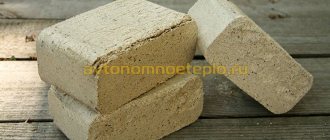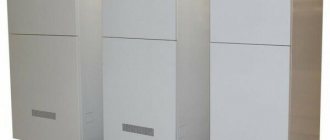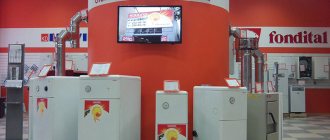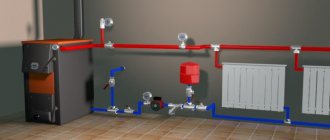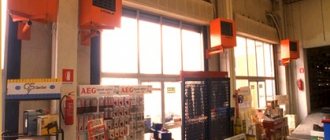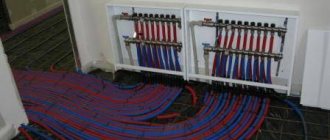The problem of uneven heating of radiators and floor heating pipes is associated with airing of the system. As a result, air accumulates at the top and the battery screen or section of piping remains cold, since hot water cannot fill this space. The automatic air vent releases air accumulated in the circuit and increases the surface area of the screen, which serves for heat exchange with the room.
- What it is
- Operating principle of air vents
- In a private house
- In an apartment building
- Advantages in automation
- When it's needed
- Tips for choosing
- Video: how to bleed air from a radiator manually
- Varieties
- Verified models: top 5 for 2022
- Operating instructions
- Video: installation of an air vent
- Set it and forget it: is that true?
- What equipment can replace it?
Automatic vent valve for heating system
A heating system with a liquid coolant uses a number of specialized elements to ensure reliability and efficiency of its operation. These include an air valve (separator) for heating. A device for releasing air from the heating system makes it possible to remove gases accumulated in the pipeline and radiators.
When an air plug forms in the pipeline, it tends to the highest point of the radiator or the heating circuit as a whole. If an automatic air release valve is installed in this place, the coolant from its internal chamber is displaced by gases.
When the liquid is displaced, the float moves down and opens the valve, as a result of which gases are released from the heating pipeline, and the chamber is again filled with coolant.
The valve for automatically releasing air from the heating system becomes silted over time and becomes overgrown with scale. This leads to jamming of the mechanism, loss of tightness of the valve - moisture begins to seep through it. Such a device requires replacement - automatic air vents cannot be repaired.
The number of automatic air vents depends on the characteristics of the heating system.
- Device required for installation:
- as part of the safety group of the boiler unit at the outlet pipe of the water jacket, where the coolant is heated to the maximum temperature;
- at the highest point of vertical risers - this is where gaseous substances rise and accumulate;
- on the distribution manifolds of underfloor heating so that air can be vented from the circuits;
- on U-shaped loops made of polymer pipes, which are installed to compensate for the thermal expansion of the pipeline.
Selection principles
Air valves for the heating system can be part of a safety group or a manifold kit for a heated floor, supplied with heating appliances.
The car air vent is selected taking into account its operating parameters (maximum permissible temperature and pressure), they must correspond to the characteristics of the heating system. Based on their design, they are divided into straight and angular devices, horizontal and vertical.
- Mayevsky cranes differ in the way they unscrew the working screw:
- with a rod head for a special key (the inconvenience is that the key may not be at hand at the right time);
- with a non-removable handle (cannot be used in places accessible to young children to avoid the risk of burns from heated coolant;
- with a slot for a flat-head screwdriver (the most convenient and safest option).
To equip your heating system with a reliable air release valve, it is recommended to choose products from well-known brands. You should avoid cheap products made from fragile silumin that imitates brass.
Why is air in a heating system dangerous?
Air dissolved in the coolant gradually damages steel pipes and radiators and elements of the boiler unit. The corrosive activity of air, which was first dissolved in water and then released during heating, significantly exceeds that of atmospheric air due to the increased oxygen content.
Gases accumulated in the pipeline not only provoke or accelerate corrosion of metal elements, but also form air locks that prevent the heating system from functioning fully: Due to gas locks, the circulation of the coolant worsens; in serious cases, the movement of liquid through the pipes can be completely blocked. In such a situation, heating devices quickly cool down. Air pockets act as a heat insulator, and if gases have accumulated in the upper part of the battery, it warms up worse and transfers less thermal energy to the room. If there are air pockets, the movement of the coolant along the heating circuit is accompanied by loud gurgling sounds and murmurs, which disrupts the acoustic comfort in the house.
Circulation pumps are not designed for pumping gases; when working with air-filled coolant, the bearing and impeller of the pump unit wear out much faster. Special air exhaust devices help solve problems associated with airing the heating system
It is important to choose the right valves for bleeding air and correctly determine the location of these elements.
https://youtube.com/watch?v=Q4LOLnuFOoc
What equipment can replace it?
An automatic device has advantages, but such air vents are not installed on old cast-iron radiators. The most popular replacement option will be a manually operated Mayevsky crane. The reliability of the design lies in the fact that there are no moving parts inside the body that become clogged or rust. A manually operated mechanical valve is still a popular device along with automatic air vents.
Consequences of the absence of an air vent in heating
The functioning of the heating complex is based on the circulation of the medium in the pipeline and the transfer of part of the heat to heating devices. The latter, in turn, share this heat with the room in which they are located. An air plug formed in a pipeline or in a radiator (airing) leads to a disruption of the entire process: the circulation of the coolant becomes difficult or stops completely. What else is fraught with the absence of automatic air vents in the heating circuit?
- noisy movement of the carrier in pipes, vibration, increased likelihood of destruction at soldering points;
- airing in remote sections of the pipeline, in areas where the temperature regime is not constantly monitored, can cause a stop in circulation through some radiators. In some cases, this can lead to defrosting of the entire heating complex;
- reduction in the efficiency of heat supply and excessive consumption of heating raw materials;
- failure of radiators caused by corrosion. Corrosion occurs as a result of air entering the internal walls of the batteries.
Automatic air vents are the same necessary components of the heating system as heating devices, pipes and a heat generator. Automated devices enable the heating complex to function fully and maintain all other elements of the circuit in operating condition.
Device structure
Manufacturers produce models of automatic air valves with angled and straight connections. In the latter option, air is ejected upward at a right angle. In the first case, from a side tap equipped with a nozzle (calibrated hole for dosed gas release).
Manufacturers are constantly improving models, equipping them with additional functions that increase the reliability and ease of use of air vents.
You can buy devices:
- with a protective plate against water hammer (for these purposes, the device is equipped with a plate installed at the entrance to the chamber);
- trapping air bubbles (this function is available in automatic flow-type air vents equipped with fittings for connecting to the network; a storage tank is installed in the chamber of the lower zone to trap air bubbles);
- with the ability to dismantle the air vent without removing coolant from the tanks for cleaning or maintenance (installation of a shut-off valve with a spring on the fitting).
You can learn more about the functions and additional capabilities of the models when purchasing automatic air vents for heating systems from store managers.
Why are automatic air vents installed on steam lines?
The main idea of using air vents (thermostatic steam traps) is to remove “air pockets” from the steam line, which lead to an increase in system warm-up time, as well as a decrease in consumer productivity. The presence of air and non-condensable gases in the steam pipeline is dangerous for several reasons:
- Decline in overall system efficiency. It warms up more slowly with air, and as a result, steam with lower parameters than necessary reaches the consumer. Heat transfer can be reduced by up to 50%, which means additional costs will be required to raise the temperature to the desired values.
- Oxygen, which is part of the air, is a strong oxidizing agent. At high concentrations, it can cause pitting corrosion of the metal of the steam pipeline.
- Non-condensable carbon dioxide CO2, dissolving in the condensate, forms carbonic acid, under the influence of which, over time, the main components of the steam pipeline are destroyed and its tightness is broken.
The use of automatic air vents allows you to automate the process of releasing air from the steam pipeline, eliminating human participation in servicing the steam-condensate system. First, it will free up staff to do other work. Secondly, air vents are installed at the highest levels of the pipeline, which are usually difficult to access.
Installation principles
The automatic air release device is installed vertically - for both straight and corner models, the cap covering the outlet is directed upward. A ball valve or shut-off valve must be installed in the pipeline before the drain valve.
Attention! An exception is the air vent in the boiler safety group - there should be no shut-off valves between this unit and the boiler pipe.
A shut-off check valve allows you to clean the air vent or replace a faulty device without draining all the coolant from the circuit. The automatic air vent with a check valve is easy to use.
When installing an automatic Mayevsky crane, use a wrench rather than an adjustable wrench to control the tightening force of the fasteners. In this case, you should not hold the device by the body, so as not to break it. Hold the air vent by the hexagon under the cylindrical chamber.
Ways to combat system airiness
To remove air accumulated in heating pipes, special devices are used - air vents. They must be installed on each radiator. including steel, at the outlet of heating devices or at the highest points of the circuit, where released oxygen is concentrated.
You can find various modifications of such fittings on the market; the most common are devices made in Italy and Germany. With the same purpose, two fundamentally different types are distinguished.
Handheld devices
Mayevsky valves, or manual air vents, are used to discharge accumulated air in the circuit. They have a fairly simple design and consist of a screw that covers a needle-shaped hole in a brass body.
All parts of the device fit tightly and when closed do not allow coolant to pass through. Gases are released through a hole located in the side of the housing. Recently, fittings with metric threads have become more popular, which greatly simplifies their production. In various designs, adjustment can be made in several ways:
- unscrew with a screwdriver;
- open using a special square ICMA key;
- turn away with your hands.
Most often, manual taps are installed on radiators, screwed into the top hole. Such fittings are selected depending on the diameter.
Often these devices are installed on other devices. They are attached to heated towel rails using a tee. In two-story houses with top supply, all appliances located on the top floor must be equipped with Mayevsky taps.
After filling the system or before the heating season, it is necessary to bleed off the accumulated air. To do this, turn the hand tap counterclockwise and the oxygen leaves the device. Usually one turn is enough, but if a large volume of gases has accumulated, you can tighten the valve another half turn. It needs to be shut off when water begins to come out instead of gases. In systems with forced circulation, the pump is first turned off, and after a few minutes the accumulated gases are released. When the pump is running, it is impossible to collect all the air at the location where the valve is attached and the plug will not be removed.
Sometimes there are manual air vents not with a needle rod, but with a metal ball that blocks the hole for releasing oxygen. The design of the body may also differ, allowing installation of the crane both straight and at an angle.
Automatic valve
The operation of air vents, which operate automatically, is based on the float-valve principle. A float is installed in the brass body, connected by means of a lever to the outlet valve. The float constantly floats in the water, while the valve is closed. If air accumulates, the float lowers and opens the valve. The gas escapes into the atmosphere through a narrow opening between the float and the body.
Then the reverse process occurs. As air escapes, the housing is filled with coolant and the float rises, closing the valve. If the air vent breaks down, there is no leakage of liquid due to the presence of locking caps in the design. An automatic air vent is installed in the system through a special shut-off valve, which closes when the device is removed. This allows repair work to be carried out without draining water or releasing pressure.
https://youtube.com/watch?v=8PSjHc4kPcI
Such devices are installed at the highest points of the system and are located vertically. Most often they are installed in such critical places:
- on a heating boiler;
- at the top point of the riser;
- on collectors;
- on air separators.
Wider use is hampered by the low quality of process water. Small particles floating in the liquid clog the air vent and the equipment stops working. A fundamental change has been made to the design of AFRISO fittings:
- increased hole size;
- the outlet channel is located in the middle of the float.
This design allows the air vent to work more efficiently and regardless of the quality of the coolant, and its maintenance and cleaning have also been greatly simplified.
Where are air vents installed?
In a closed system, when installing a device for effective gas removal, certain rules must be observed:
- The pipes are laid so that the vectors of movement of water and air coincide, and the hot liquid is directed from the main riser to distant ones.
- The air collector must be mounted at the highest point, for example, when going around a doorway from above, since air is released from the liquid at low water speed.
- Devices for removing air should be placed in areas where gas accumulation is guaranteed: at turns of risers, in places where pipes change to another cross-sectional size, on all batteries, separators, and combs.
It is mandatory that air vents are mounted on aluminum radiators, which release hydrogen upon contact with the coolant. For partially bimetallic batteries, the problem is not so urgent, but they do contain aluminum, which means that gas will have to be removed, although not so often. There is no aluminum in 100% bimetallic models, but manufacturers strongly recommend using them together with devices for bleeding air.
With steel panel batteries, due to their special design, the air release valve is installed at the factory.
Modern air vents are not effective on traditional cast iron batteries and pipes. Bleeding gases in such structures is possible only with part of the coolant, so standard and ball valve options are used. A specialist’s opinion on where and how it is advisable to install air vents is in this video:
Selecting an automatic air vent
To independently select equipment for a boiler, battery or other element of the heating system, you must consider:
- device type;
- material of manufacture;
- technical parameters of equipment;
- manufacturer.
Varieties
Manufacturers produce automatic air vents of the following types:
straight. A device with a straight pipe is mounted on the highest point of the heating system, heating boiler or circulation pump;
Direct type air removal device
angular. The valve is installed on horizontal sections of the heating system or in hard-to-reach places;
Angle type air removal device
radiator The device is mounted directly on the battery instead of the usual Mayevsky crane.
Equipment for heating radiators
Regardless of the type of equipment, the operating principle of all air vents is the same.
Materials used for manufacturing
Automatic float-type air vents can be manufactured:
- made of stainless steel. The devices are characterized by a high level of corrosion resistance, low weight, but at the same time relatively high cost;
- made of brass. The brass valve is low cost. To protect equipment from corrosion, a nickel or zinc coating is additionally applied;
Equipment made of nickel-plated brass
- made of cast iron. Due to its large weight and specific qualities, it is currently used exclusively in the presence of a heating system made of a similar material;
- from copper, nickel and other alloys.
To make a float, polyethylene is most often used, which is durable, not susceptible to high temperatures and impurities.
Determination of technical parameters
An air vent with a check valve or a direct valve must be selected in accordance with the parameters of the heating system. Of significant importance are:
- type of coolant. Devices designed for water, non-aggressive environments, and so on are produced;
- maximum temperature of the media in the system. Most modern models are designed for temperatures up to 120°C;
- maximum ambient temperature;
- internal pressure in the heating system.
Additionally defined:
- nominal diameter (diameter of equipment);
- height and width of equipment;
- type and pitch of thread.
All parameters of the air vent are indicated in the accompanying documentation.
Basic selection options
Review of popular manufacturers
The service life and reliability of equipment intended for the heating system of a room is in most cases determined by the manufacturer. The most popular are:
Flamco company (Netherlands). Air vents of the Flexvent brand are manufactured with low or medium power and are mainly intended for household heating radiators;
Equipment made in the Netherlands
- ADCA (Portugal). The company specializes in the production of equipment for industrial heating networks, characterized by high power and throughput;
- Valtec (Italy). The manufacturer produces various types of equipment for various heating systems. It is characterized by wear resistance, a high level of tightness and a long period of use (more than 10 years), as well as reasonable cost;
Heating equipment from an Italian manufacturer
- Danfoss (Denmark). Air vents of the Danfoss Airvent series are made of brass. The main advantages are a long period of use (from 10 years), high quality and a large assortment. Among the disadvantages, we can highlight the cost of products, which is 1.5 - 2 times higher than analogues;
- Itap (Italy). The equipment has an acceptable cost and a long service life.
- Navien (Korea). Navien's products are popular due to their low cost and quality, which is achieved through the use of spare parts manufactured in Japan.
The design, principle of operation and types of air vents operating in automatic mode are presented in the video.
You can install an automatic air vent from Valtec or another manufacturer yourself. During installation, additional care should be taken to ensure the tightness of the threaded connection and use FUM tape, flax thread or other sealing agents. When installing, it should be taken into account that the drain valve of the equipment must be directed clearly upward.
Review of manufacturers
Automatic air vents for gas release are:
- brass with a polyethylene float that is not subject to oxidation;
- cast iron with epoxy coating;
- brass with nickel coating and polyethylene float;
- made of stainless steel.
Among the companies producing automatic air vents for heating systems, the following brands have gained a good reputation.
- Flamco company from the Netherlands. It produces Flexvent domestic air vent valves. The body of the parts is made of brass; the products are mounted in circuits with a small amount of air masses. Mainly intended for batteries.
- The Portuguese company Adca specializes in valves for the industrial segment and heating circuits. The products are made exclusively from stainless steel and are installed in heating circuits with a maximum coolant temperature of no more than 300 degrees.
- Mankenberg produces high quality air vents. The main difference between air vents from this manufacturer is the ability to be installed in heating systems with various types of coolants, even aggressive ones. Air vents are made of stainless steel.
- produces air bleed valves mounted on water supply, heating and sewage systems. Russian-made devices are currently manufactured for heat supply systems - the KAT12 series, water and sewer circuits - the KAT50 series.
- Armstrong is considered the most sought-after manufacturer of high-end automatic air vents throughout the world.
Operating instructions
- Modern models of devices are equipped with elastic gaskets so that the connection to the radiator and pipeline is elastic and reliable.
- If the presence of a gasket is not enough, plumbing thread is wound at the joint or linen tow and putty are used.
- Installation is available without inviting a plumber. To connect to the system, just use an adjustable wrench.
- Experienced plumbers recommend installing an automatic air vent, the operating principle of which involves effective bleeding of air, not from the blind radiator plug, but on the inlet pipe - between the radiator and the tap.
Set it and forget it: is that true?
The Smart Home system implies the presence of various devices that create comfortable living in the house. The monitoring device periodically requires attention, despite its autonomous operation. Over time, the air vent begins to bleed not only air, but also water. The needle valve stops opening and closing independently due to the jamming of the polymer resin float. The light weight and soft texture of the core make it vulnerable to the slightest ingress of debris and hard abrasive particles.
How to disassemble
It often happens when using automatic air vents that they begin to leak. In this case, plaque and mechanical deposits appear on the needle-type valve. In this case, the tap closes completely, the coolant flows out, that is, the tap is leaking. It is necessary to dismantle the device, disassemble it, clean the needle itself, the seat and other disassembled parts with a soft tool. With good cleaning, you may not notice such problems until the next time precipitation occurs. To assemble the air vent, it is recommended to use FUM tape as a thread seal, and the body is screwed in by hand.
Furniture items
A few examples of furnishing a kitchen combined with a living room:
- 1. Sofa. It becomes an object that zones space. The sofa is placed with its back facing the place where food is prepared. In small rooms (less than 20 sq m) a corner is placed, which is placed against a wall installed perpendicular or parallel to the kitchen.
- 2. Set. According to designers, minimalist models without elaborate details look modern. The service, vases or glasses are placed on an open shelf. You can buy a fashionable display case for them. Furniture is placed near the wall. If the space is large (20 sq. m, 25 sq. m or 30 sq. m), then in the central part you can install an island, which also has sections for kitchen appliances.
- 3. Furniture set. The style should be combined with the design of both rooms. In small rooms, a compact table and chairs made of transparent material or painted in light colors look good. You can add a table with a round top to your living room interior. In spacious rooms, the kit is installed near the wall or in the central part. An elongated rectangular dining table would look good here.
Results
The home heating system requires the installation of valves that remove gases from the pipeline and radiators. Automatic devices eliminate the need to regularly check the uniform heating of pipes and radiators and manually eliminate air pockets.
The presence of air in the heating system is extremely undesirable. However, he gets there one way or another. This has a very detrimental effect on the quality of operation of the heating system as a whole and reduces the service life of its individual components. In order to remove accumulated air, an automatic air vent is needed.
In this article we will talk in detail about this device, the principle of its operation, marking features and popular models, as well as how to properly install it in the heating system.
Automatic air vent - how it works, why it leaks
Why do you need an air vent?
Any closed pressure coolant system must have one or more air vents. At least one of them is automatic, releasing air on its own, without human intervention, as accumulation occurs.
Or the air lock will stop the movement of the coolant completely.
Without a small device - an automatic air vent - the system will not work normally - airing will occur.
Where does the air in heating come from and how is it removed?
Air is dissolved in water (in the coolant) and is released when there are changes in pressure and temperature, forming bubbles that accumulate in the upper part of any system.
Automatic air vent design
The device is based on a housing with a float. The float is connected to a needle release valve, which is located at the very top. If the body is filled with water, the float closes the valve, and the outlet is closed. When air appears, water is displaced, the float sags, the hole opens, and air, accordingly, comes out.
The design of the automatic air vent may be different, the body is steel or bronze, the lever mechanism from the float to the needle may vary. But there is one peculiarity - it is always strictly vertical installation, only in this position the device works.
In what places are they located?
The safety group for non-automated heating systems (solid fuel boiler) is equipped with an automatic air vent. In automatic boilers, such a device is always provided inside.
As a rule, for a small home system, one such air valve is sufficient, which is complemented by Mayevsky taps - manual devices for bleeding air.
They are installed at the end of each radiator.
Where to locate – automatic air bleed points
In branched systems, automatic air vents are installed in several places. In addition to the boiler device, the following are also installed:
Equipment of radiators with Mayevsky taps
At the end of each radiator there must be a manual valve for bleeding air. The simplest device - a manual valve - the Mayevsky tap received the greatest popularity.
When the valve is unscrewed, the accumulated air is released. The coolant will flow out after the air.
Radiators are usually installed horizontally, or so that the edge with the valve is 1 cm higher. This is enough to reliably capture and remove air.
In large networks, it is advisable to tilt one of the series-connected radiators a little more and equip it with a corner automatic air vent. Such a device will serve as a separator.
Why does it flow
Plaques and salt deposits gradually form on the needle valve of the air vent. The hole no longer closes tightly - water oozes out - the device leaks.
It is also important to assemble the housing without leakage; FUM tape is usually used to seal the threads, and the housing itself is tightened by hand
How to install
There are a couple of important nuances in installing an automatic air vent. It must stand vertically, the valve hole must be straight up, otherwise it will not work. Accordingly, to install it in the line, a tee of the appropriate thread diameter is screwed into the line - 1/2 inch.
The security group comb provides its own outlet.
But the air vent is leaking, so how can you disassemble it without draining the coolant from the system?
Application of shut-off valves
The automatic air vent is a frequent maintenance device. It needs to be disassembled and cleaned to prevent leaks. But it is not at all necessary to release the coolant and reduce the pressure in the system.
The air vent is screwed into its body, presses on the lever, the valve membrane sags and the device communicates with the system. When you need to remove it, it unscrews, and the shut-off valve closes the hole.
It is recommended not to skimp and use shut-off valves.
What it is
The device that controls the removal of air from the heating circuit is a metal sealed plug. At the bottom of the structure there is a threaded pipe with which a “smart” device for the radiator is connected to a specific component of the heating system.
To understand how an automatic air vent works, pay attention to the design features:
- Has a cast brass body.
- Sealing ring.
- Locking mechanism and cover.
- The needle mechanism is connected through a flag to a float made of polymer resin.
- Jet.
Operating principle of air vents
Inside the metal body there is a float made of a light polymer alloy. In a normal, fully functioning state, there is hot water inside the cast structure. It raises the plastic core to the maximum height of the smart device’s camera. At this moment, the needle valve closes - the automatic air vent is at rest.
- If air appears in the system, the water pushes it to the surface, and it enters the chamber - the receiving area of the metal housing.
- The float, connected by a rod to the needle valve, goes down or falls due to the settled water level, and the “needle” is pulled by the flag.
- In the “open needle” position, a small hole opens in the device, and the accumulated air safely leaves the system.
- Water fills the vacated space, raising the level of the float. He pushes the needle valve up, the hole closes tightly.
An automatic air vent for the radiator removes a slight accumulation of air masses from each circuit, and the radiators fully heat the entire screen area.
In a private house
Shut-off structures are installed in individual heating lines, which are adjusted manually. Typically, a control check of the system is carried out at the beginning of the heating season. Next, as cool areas are detected on the radiator screen, the valves are unscrewed and air is released.
In an apartment building
Multi-storey buildings have closed heating systems. The coolant is under pressure, which is controlled at the outlet of the heat generator. The air vent removes air masses during the stage of filling the boiler with water. A shut-off valve allows you to isolate a section of the system or a heating unit to release air masses.
If the apartment building still has cast iron radiators connected to a common closed heating system, they are equipped with a manually operated Mayevsky tap and drain pipe.
Advantages in automation
It is almost impossible to monitor the accumulation of air in each circuit in real time. And the airiness of the system requires increased operation of the boiler and pump. To ensure that the equipment does not run idle and there is no excessive consumption of energy resources or heat loss, it is necessary to install an automatic air vent.
When it's needed
Sometimes, after the end of the heating season, the water is completely removed or changed. Due to rust removal, automatic air vents in the heating system open when the water level drops - the emptying process occurs faster. While the operation of the device on the radiator and pipes can be controlled, the underfloor heating system cannot. In this case, you cannot do without automation. The need to install automation is due to the following cases:
- Installation in radiators due to the complex circuit design, in the upper part of which convenient cavities are created for air accumulation.
- The heated towel rail is equipped with a “smart” device, since the manual control option is located high.
- For the normal functioning of the boiler piping system, it is impossible to do without automation, which will control the presence of air in the system and ensure safe operation.
- If there is a section on the route with an upward protrusion (bypass), in this case all loops or U-shaped bends are a convenient place for accumulating and automatically discharging the air mass.
- At the production stage, the collectors present in the design of the heated floor are equipped with two air vents for the return and direct coolant supply lines.
Multi-level floor
To zone the space, craftsmen install floors at different levels. They advise installing a podium to separate the kitchen and dining room. This option is considered one of the most practical because, among other things, the owners have additional free space where they can hide something.
It is convenient to use boxes or crates for this. Wicker baskets will look good. But such space can remain free.
However, such a design should not be made if there are small children in the family, since the podium can become an obstacle for him. In addition, various floor coverings can be used.
They will zone the space between the living room and the kitchen and protect the podium from damage. For example, tiles are laid in the kitchen area, and laminate flooring in the dining room. The main thing is to choose colors and textures and combine the finishes correctly.
Types and markings, popular models
There are several types of automatic air vents. All of them are divided into two large types: automatic and manual air vents for radiators or Mayevsky taps.
Depending on the diameter of the threaded connection, they are of two types: 1/2 and 3/4 inches. The first is better known by Russian markings as an automatic air vent valve Du 15, the second - Du 20.
According to the method of fastening, they are divided into classic straight and lateral. For air vents of the second type, the threaded connection is rotated 90 degrees. The air release valve may also be located on the top or side. Various modifications are produced by the manufacturer to facilitate installation in difficult places in the heating system or for mounting on the side of radiators.
Photo 3: Automatic air vent DN15 “Valtec” VT 502 with shut-off valve
In the domestic market, the two most famous are Danfoss. supplies the Russian market with an automatic air vent VT.502 with a mounting diameter of 1/2 (DN15). The model has proven itself well and is very popular among installers of autonomous heating systems in private homes. It has a brass body coated with a layer of nickel, which is designed for a maximum pressure of 10 bar and a temperature of 110 °C. The average price at which you can currently buy this model is 280 rubles.
Photo 4: Automatic air vents 1/2 "Danfoss" series "Eagle" and "Wind"
Takes second place. It produces automatic air vents in two series: “Eagle” and “Wind”. Despite the general technical characteristics, they differ only slightly in appearance. The models are made in brass cases and are designed for a maximum pressure of 10 bar and a temperature of 120 °C. In addition to the standard mounting thread DN15 (1/2), Danfoss also produces automatic air vents with fastening 3/8 (DN10). Prices for these devices are also within 300 rubles.
Return to contents
Air vents: the main task
A device for releasing air from the heating system makes it possible to remove gases accumulated in the pipeline and radiators.
Airing of the system occurs for a number of reasons, including
:
- Due to the high content of dissolved gases in the coolant, which has not undergone special preparation - deaeration. The solubility of gases depends on the temperature of the medium, and when the coolant is heated, air separates from the water and accumulates, forming plugs.
- Due to the excessively rapid filling of the circuit with coolant, the liquid in the branched network does not have time to naturally displace the air. The coolant must be poured from the bottom point so that the air is displaced to the top and escapes through the open valve.
- Due to the penetration of air through the walls of a polymer pipeline, if it is made of a material without a special anti-diffusion coating. When choosing pipes, this point should be taken into account.
- During repair work involving the replacement of elements without completely draining the coolant, in this case the heating device or circuit being repaired is cut off from the rest of the system and then connected back.
- In case of loss of tightness.
- As a result of corrosion processes, when oxygen interacts with iron, hydrogen is released from an air molecule, which also accumulates in the system.
Why is the air in the heating system dangerous?
Air dissolved in the coolant gradually damages steel pipes and radiators and elements of the boiler unit. The corrosive activity of air, which was first dissolved in water and then released during heating, significantly exceeds that of atmospheric air due to the increased oxygen content.
Installation locations of air separators in the system
Gases accumulated in the pipeline not only provoke or accelerate corrosion of metal elements, but also form air pockets that prevent the heating system from functioning fully.
:
- Due to gas locks, the circulation of the coolant deteriorates; in serious cases, the movement of liquid through the pipes can be completely blocked. In such a situation, heating devices quickly cool down.
- Air pockets act as a heat insulator, and if gases have accumulated in the upper part of the battery, it warms up worse and transfers less thermal energy to the room.
- If there are air pockets, the movement of the coolant along the heating circuit is accompanied by loud gurgling sounds and murmurs, which disrupts the acoustic comfort in the house.
- Circulation pumps are not designed for pumping gases; when working with air-filled coolant, the bearing and impeller of the pump unit wear out much faster.
Special air exhaust devices help solve problems associated with airing the heating system
It is important to choose the right valves for bleeding air and correctly determine the location of these elements
Types of air vents for heating
Based on the type of manufacturing, devices are divided into three directions:
- Angular;
- Straight type;
- Radiator type.
The most popular devices are those with a direct connecting tube. They are often used in various fields. Of course, automatic air vents are designed to remove air through the points of the heat-conducting network located at the top.
Closed heating systems under pressure are equipped with parts to protect the boiler; they are provided on the supply pipe leaving the heat generator. In addition to the safety valve and thermal pressure gauge, a self-acting air valve is also connected here.
It removes the air that entered when liquid was poured into the boiler tank. Oxygen removal devices are also used in separate circulation pumps. Their purpose is to promote trouble-free operation of the pump. The pump device is capable of moving only water or other liquid.
The penetration of air into the pipeline threatens to stop, so the air vent allows oxygen to be removed from the pipes in a timely manner.
What to do if the air vent does not work
Air vent malfunctions often occur when air is not released from the system. This happens because the drain hole becomes clogged with scale. From time to time it needs to be freed from scale and rust.
To do this, unscrew it, first closing it off from the environment with shut-off valves and draining the water from the repair section of the pipeline
Next, the valve is removed, disassembled, and the needle is carefully cleaned. After cleaning is completed, seal the housing parts and reinstall them
In order to prevent clogging of the automatic vent, experts recommend installing a Valtek filter to purify network water. For dismountable structures, there is often a leak through the seal between the body and the head.
It is almost impossible to replace it, since such seals are not sold in the retail chain, so if such a problem occurs, it is better to use fum tape or silicone sealant. The cause of the leak may be a misalignment of the float; it is easy to fix it yourself.
Thus, we can summarize that the air vent is a mandatory element of any heating system, both central and individual, its installation is in accordance with the current rules. Automatic air vents are used to continuously remove air pockets without operator intervention.
Installation Rules
Air vents are installed vertically, with the safety cap facing up. In the highest places of the pipeline system and on batteries. The housing has a mounting hexagon, which is used to connect the vent to the heating system with an ordinary wrench.
In this case, installation with a key behind the housing is not allowed, since this can lead to its destruction and disruption of the functionality of the entire heat supply system.
When installing the air vent on the radiator, the latter must be installed with a slight slope, so as to raise the last section in which the air vent will be installed.
A ball valve or shut-off valve is installed in front of the vent. This is done so that the air vent can be replaced without draining water from the entire intra-house network.
Design and operating principle of manual air valve
The needle manual air valve is also called a Mayevsky valve. His device:
- Brass body (plug) with external thread 1/2 // or 3/4 // for connection to the radiator. The case has two holes for air release Ø 2 mm - one at the end of the case, the second on the side wall;
- Brass locking screw. On one side of the screw there is a groove for a slotted screwdriver, on the other side the screw is machined into a cone that closes the air hole (the “closed” position);
- Plastic casing.
On sale you can find the so-called “faucet at hand”. To use it, you don’t need a key or a screwdriver—the plug can be easily unscrewed by hand.
To remove air from the housing, you need to unscrew the screw. To do this, you can, of course, use a screwdriver, but there are special keys that are most often included. After several revolutions, the screw cone comes out of the end hole and air enters the housing cavity, which is immediately released through the second side hole. The main thing is not to rush to turn off the tap. About 30 - 40% of the air should come out with water, so you need to stock up on time, a basin and rags. After the air has been released, the lost water must be added to the system.
Modern aluminum or bimetallic heating radiators already have a hole for installing a Mayevsky tap. It can be found on the side opposite the coolant supply, from above. Most likely, there is already a nut for installation there. There is a plastic plug screwed into it. After its removal, an air valve is installed in this place. Before this, the tap threads must be sealed with a rubber or silicone gasket.
Installing a Mayevsky crane on a cast iron battery is much more difficult. Let's start with the fact that these valves are much more powerful than those on aluminum radiators - they can withstand pressures of up to 16 atmospheres and temperatures of 150 C°. Sequencing:
- 1 Drain the water from the radiator;
- 2 Cut a hole in the top plug of the cast iron battery and cut a thread that matches the external thread of the air vent;
- 3 Screw in the Mayevsky tap;
- 4 Add water to the system.
Malfunctions and ways to eliminate them
If the faucet malfunctions, a leak appears. There may be several reasons for this:
- Manufacturing defects. One in fifty taps does not hold pressure at all. The only way out is replacement;
- The screw is too short. In this case, its conical part cannot completely block the hole, so you need to apply a certain force to screw the screw in until it stops;
- Solid particles of debris falling between the screw and the housing can damage the internal threads. Fum tape can help here once, but later you will still have to change the tap.
Distinctive features of air vents
Automatic air vents have different designs, depending on the manufacturer.
Here are the main differences:
- There is a reflective plate in the center of the body. Installed at the entrance to the working chamber, it protects the elements inside from hydrological shocks;
- Many models are supplied with a spring shut-off valve and an air vent screwed into it. When the shut-off valve is removed, the spring is compressed and the sealing ring blocks the outlet channel;
- Some models of self-acting air vents are designed to work together with radiators; they are not straight, but have threaded side tubes of the appropriate size for screwing into the radiator inlet.
If necessary, corner self-acting air exhaust devices of various types can be used to connect heated floors, as well as hydrological arrows.
Air removal methods
The air lock cannot be in an easily accessible place all the time. During installation or design errors, air accumulates in the pipes. It is quite difficult to remove it from there. To do this, you first need to identify the location of the plug. In the area where it appears, the pipes become cold, and you can also hear a murmur inside them. If there are no obvious signs, then you can check the pipes by sound by tapping. In the area where the airlock accumulates, the sound is louder and more sonorous.
Read also: how to properly bleed air from a heating battery.
After this, the air must be expelled. If we consider the heating system of a private house, then for this we need to increase the pressure or temperature. To increase the pressure, you need to unscrew the make-up valve and the nearest air release valve. Water will begin to flow into the heating circuit, increasing pressure, which forces air to move forward. The plug will come out after it hits the drain valve. When all the air masses are completely released, the air vent will stop hissing.
But not all air pockets can be removed in this way. In certain cases, it is necessary to increase both pressure and temperature simultaneously. These indicators need to be raised to values that are close to critical, but they cannot be exceeded. If after the procedure the air does not come out, you can try opening the drain and make-up valve additionally. It may be possible to move the air plug this way.
If the problem appears regularly in one area, it means that the culprit is incorrect pipe routing or an error in the design. In order not to suffer all the time during the heating season, a release valve is cut into the problem area. You can install a tee in the pipeline and install a valve at the free entrance. In this case, the problem can be solved very simply in the future.
Automatic fresh air valve AERECO:
Which is better: automatic or manual Mayevsky crane
No matter how attractive the operation of an automatic air release valve may look, no matter what advantages it promises, there are still some circumstances that do not speak in its favor. Or at least talking about the economic inexpediency of installing an automatic machine. Such circumstances are rare, but nevertheless they occur.
- First of all, these are central heating systems with cast iron radiators. There are several reasons why it is better not to install automation. Firstly, there is dirt, of which there is a lot in metal pipes and cast iron batteries - the machine will quickly become clogged with silt and will have to be cleaned frequently. If this does not bother you, then another question arises - removing the machine when the system is full and cleaning it will not work. Although, if you still want to install it, you can additionally install a small valve in front of the machine, which will prevent the coolant from flowing out of the system after you remove the automatic air vent. If this doesn’t stop you, then think about how often you will bleed the air from the central heating battery. I am absolutely sure that 90% of residents of multi-storey buildings do not do this even once during the heating season. But it’s somehow unreasonable to install it just in case - just in case, you can get by with a cheap Mayevsky manual crane.
Automatic air vent photo
Why such distinctions, you ask? Everything is quite simple - an automatic air vent costs at least 10 times more than a Mayevsky faucet. So if there is no special need for it, you can refrain from unnecessary expenses. By the way, I completely forgot to say - any automatic air vent can be used in manual mode. To do this, it is additionally equipped with a spool valve - you just need to press a match or something else thin on its internal pin, and the air will come out. Alternatively, if you don’t have it, some water will do.
Features and varieties
Technical features of automatic cranes:
- service life: 25-30 years;
- maximum temperature of water and other non-aggressive liquids: no more than 120 degrees;
- room temperature: no more than 60 degrees;
- pressure: 10-12 atmospheres;
- threaded connection: 1/2 or 3/4;
- thermal agent: water and non-aggressive liquids.
The quality of automatic air vents must meet all the requirements of GOSTs and quality certificates. Every year, the devices of automatic valves for releasing gases are being improved.
Modern manufacturers are trying to eliminate unpleasant moments that may arise during the operation of air vents.
- Use of reflective plates on the inlet pipe to avoid water hammer.
- Equipped with fittings for quickly releasing small air bubbles. At the bottom of the tank there is a filler designed to trap moving air bubbles.
- Equipping the radiator plug with a mini valve.
Depending on the manufacturing method, automatic float air vents can be presented in several types.
With straight pipe or manual.
The most popular devices, since they can be installed almost everywhere:
- At the upper ends of vertical risers. Since air tends to get to the top, an installed air vent will allow gas to be released from the upper points of the circuit.
- Member of the heating device safety group. The safety group is located on the suction heat pipeline after the heat generator. This also includes a pressure gauge and a safety check valve. The automatic valve is designed to remove the gas-air environment when the level in the expansion tank rises. With proper piping of the equipment, you can separate the device with shut-off valve 1⁄2 and remove the liquid medium using an air vent; after all work is completed, you can refill the system with coolant.
- In circulation type pumping units to ensure stable operation. Pumping equipment transports only liquid media, and the entry of air into the unit will cause it to stop. But thanks to an automatic air vent, steam or air will be removed before entering the pump.
- Angular.
- For radiators.
In closed heating systems, it often happens that gas-air masses accumulate in hard-to-reach or remote places. In cases where conventional valves cannot be installed, since the threaded pipe at the end is located horizontally, corner automatic air vents will be the optimal solution to this problem. The device's pipe is rotated 90 degrees, which allows it to be connected to a horizontal pipe. You should know that corner air vents are practically no different from traditional straight air vents and can be installed instead of them.
There is no point in installing a corner air vent, since there are special automatic air vents. Such devices are mounted exclusively on radiators and have appropriate threads. They are also preferable to manual air vents on aluminum or bimetallic heaters, where the alloy can interact with the coolant. In all other situations, automatic radiator valves are installed at the discretion of the owners. Conventional cast iron radiators in a centralized heating system are equipped with Mayevsky manual valves and a drain element.
For practicality and ease of cleaning, automatic float valves are produced complete with a valve, which is the smallest adapter with a petal-type pipe. An adapter screwed onto a threaded connection is installed before the air vent and is necessary for quick dismantling and cleaning, as well as replacement. Automatic cranes from manufacturers such as Danfoss and Valtec are equipped with similar elements.
Manual way to remove air from batteries
And yet, more often manual models are installed on radiators. And the most common of them is the Mayevsky crane. It is small, simple and effective. It is also called a needle air vent valve.
It is a metal washer with a thread applied around the circumference. The washer has a through cone-shaped hole with threads. The hole diameter is very small. On one side 1-1.5 mm (towards the radiator) and about 5 mm on the other.
Diagram of the Mayevsky crane
A locking cylinder is screwed into the hole, which is also threaded. When closed, it blocks the coolant flow completely. The cylinder is unscrewed, the cone is lifted, the hole opens. If gases have accumulated in the radiator, they come out. If there are no gases, the coolant comes out. But there cannot be a lot of it: not much will leak into a hole with a diameter of 1 mm.
In some models, a plastic disk with a drain hole (also about 1 mm in diameter) is attached to the body. This disk turns freely around a horizontal axis, which allows you to set the drain hole in a convenient position.
